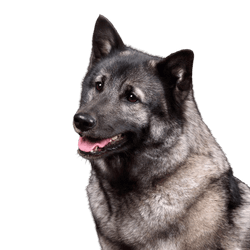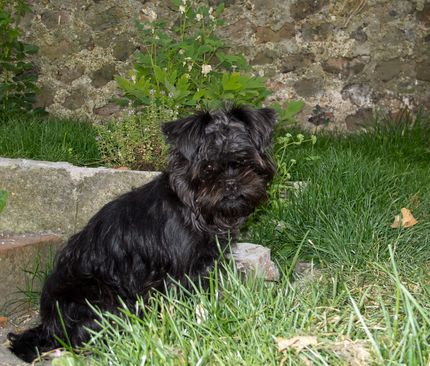Facts & Origin
Elk-a-Bee (Norwegian Elkhound Grey and Beagle Mix)
The Elk-a-Bee is a cross between the Norwegian Elkhound Grey, an ancient Nordic breed used for hunting moose and other large game, and the Beagle, a smaller breed of dog originally bred for hunting hares in England. These two strong hunting dog breeds make for an energetic, robust, and adaptive dog that is ideal for active families.
Suitability and attitude
The Elk-a-Bee is best suited for families who spend a lot of time outdoors and can provide their dog with the exercise and mental stimulation they need . Due to their strong hunting instincts, it is important to have a secure and fenced yard. Despite their independence, they appreciate the company of their humans and should not be left alone for long periods of time.
| Alternate Name | - |
| Origin | UK - Norway |
| Life expectancy | 10 - 15 years |
| Care requirements | low-maintenance - high-maintenance |
| Activity level | average - high |
| FCI group | not recognised |
| AKC group | not recognised |
| KC group | not recognised |
More Beagle mixes
More Norwegian Elkhound grey mixes
Attitude, character and temperament of the breed
Possible character traits
The offspring of two active hunting dog breeds , the Elk-a-Bee is characterized by intelligence, energy and a strong hunting instinct. They are bold and independent, but can also be loving and friendly towards their family. Socialization at a young age is of great importance to ensure they get along well with people and other animals.
In summary, the Elk-a-Bee is an active and engaging breed that is both physically challenging and a source of love and loyalty for its owners. With proper care and attention, this sturdy and reliable dog is sure to become a valuable member of any family.
Character
Usage
Grooming and health
In terms of grooming, the Elk-a-Bee's thick coat requires regular brushing to prevent dandruff and matting. Ears should be checked and cleaned regularly to prevent infections, as both parent breeds can be prone to this.
In terms of health, the most common health problems of Elk-a-Bees are hip dysplasia, certain eye problems, and hypothyroidism, which they can inherit from their parent breeds. Regular health monitoring and a healthy lifestyle can help prevent or control these problems.
What does this mixed breed look like?
In terms of appearance, the Elk-a-Bee is a medium-sized dog whose physique reflects the power and strength of the Norwegian Elkhound, with the more compact size of the Beagle. It can reach a weight of about 9 to 18 kilograms and a height of 33 to 45 centimeters at the shoulder. The coat is usually thick and dense, a trait they inherit from their Elkhound parent. Coat colors vary, but are usually a mixture of the colors of the Beagle and the Elkhound, often gray, black and white.
| Fur length | short - long |
| Fur | flat coated - |
| Ear shape | Floppy Ear - Standing Ears |
| Tail | lang - rolled up |
| Anatomy | rugged, massive, sporty |
| Size ♀ | 33 - 46 cm |
| Weight ♀ | 9 - 25 kg |
| Size ♂ | 36 - 49 cm |
| Weight ♂ | 10 - 24 kg |
| Suitable For | - |
Known Diseases
Hypothyroidism
Hypothyroidism is a condition in dogs where the thyroid gland does not produce enough thyroid hormones. This can lead to a slowed metabolic rate, weight gain, fatigue, hair loss and other symptoms.
Epilepsy
Definition: Dog has epilepsy if, for example, at least two epileptic seizures occur more than 24 hours apart.
Eye diseases
Often occur with allergies and intolerances.
Overweight
Often, unfortunately, the dogs very much under excess weight. But the dogs themselves are never to blame!
Disc problems
Herniated disc in dogs (discopathy). Herniated discs or dachshund paralysis cause dogs severe pain.
FAQ
-
As a hybrid breed, the Elk-a-Bee is not assigned a country of origin.
-
They are generally intelligent, lively and friendly dogs that require a great deal of freedom of movement.
-
Yes, they need a lot of mental engagement and regular exercise to effectively channel their existing energy potential. They need regular brushing to keep unwanted fur out of the house.
-
Yes, these mixed breeds are usually very good as family dogs as they are very friendly and lively in company. However, they need an experienced owner who can teach them how to behave appropriately.
-
The average life expectancy is 12 to 15 years.





















